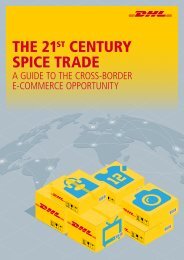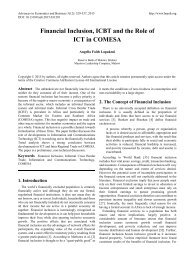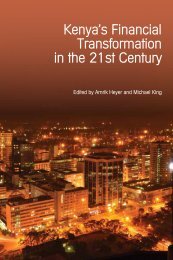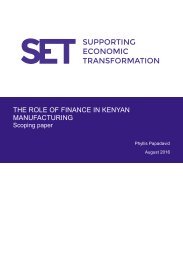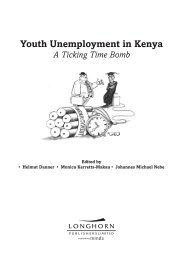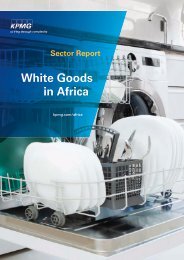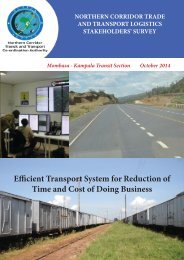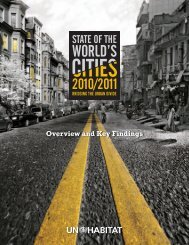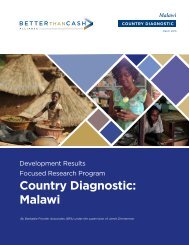FD
gvti301SEaf
gvti301SEaf
Create successful ePaper yourself
Turn your PDF publications into a flip-book with our unique Google optimized e-Paper software.
Closer look<br />
By assigning scores on each dimension, the index allows<br />
regions to see exactly where they fall short.<br />
(score on each dimension by regional economic community)<br />
Trade<br />
Integration<br />
Regional Productive<br />
Infrastructure Integration<br />
Free Movement<br />
of People<br />
Financial<br />
Integration<br />
CEN-SAD 0.353 0.251 0.247 0.479 0.524<br />
COMESA 0.572 0.439 0.452 0.268 0.343<br />
EAC 0.780 0.496 0.553 0.715 0.156<br />
ECCAS 0.526 0.451 0.293 0.400 0.599<br />
ECOWAS 0.442 0.426 0.265 0.800 0.611<br />
IGAD 0.505 0.630 0.434 0.454 0.211<br />
SADC 0.508 0.502 0.350 0.530 0.397<br />
UMA 0.631 0.491 0.481 0.493 0.199<br />
Average 0.540 0.461 0.384 0.517 0.381<br />
Sources: Economic Commission for Africa, African Union Commission, and African<br />
Development Bank (2016).<br />
CEN-SAD = Community of Sahel-Saharan States, COMESA = Common Market for Eastern<br />
and Southern Africa, EAC = East African Community, ECCAS = Economic Community of<br />
Central African States, ECOWAS = Economic Community of West African States, IGAD<br />
= Intergovernmental Authority on Development, SADC = Southern African Development<br />
Community, and UMA = Arab Maghreb Union. Scores are calculated on a scale of 0 (low)<br />
to 1 (high).<br />
the exception of Kenya and South Africa. For instance, while<br />
Nigeria represents 37 percent of regional GDP, it is not a top<br />
performer on regional integration, nor is Egypt. Conversely,<br />
countries such as CÔte d’Ivoire, which contributes only<br />
3 percent of regional GDP, are among the top performers.<br />
So what does all this mean for Africa’s integration, and<br />
does the multiplicity of regional groupings help or hinder it?<br />
Although the index cannot directly answer this question,<br />
other research (Economic Commission for Africa, the<br />
African Union Commission, and the African Development<br />
Bank, 2012) clearly shows that Africa’s regional economic<br />
communities have been the locus of many effective integration<br />
measures, particularly in the areas of trade integration<br />
and free movement of people. While these efforts represent<br />
progress, the multiplicity of standards, rules of origin, and<br />
regimes that span the continent surely increase the burden<br />
of compliance on African businesses. Africa needs to harmonize<br />
integration policies across its various regional blocs. ■<br />
Carlos Lopes is a United Nations Under-Secretary-General<br />
and Executive Secretary of the Economic Commission for<br />
Africa.<br />
This article is based on the Africa Regional Integration Index Report<br />
2016 of the Economic Commission for Africa, the African Union<br />
Commission, and the African Development Bank.<br />
References:<br />
Economic Commission for Africa, the African Union Commission, and<br />
the African Development Bank, 2016, Africa Regional Integration Index<br />
Database (Addis Ababa).<br />
———, 2012, Assessing Regional Integration in Africa V: Towards an<br />
African Continental Free Trade Area (Addis Ababa).<br />
United Nations Statistics Division (UNSD), 2016, UNdata.<br />
<br />
<br />
<br />
Read our blog by leading economists<br />
and IMF officials about pressing issues<br />
in the global economy<br />
http://blog-imfdirect.imf.org<br />
Finance & Development June 2016 21



